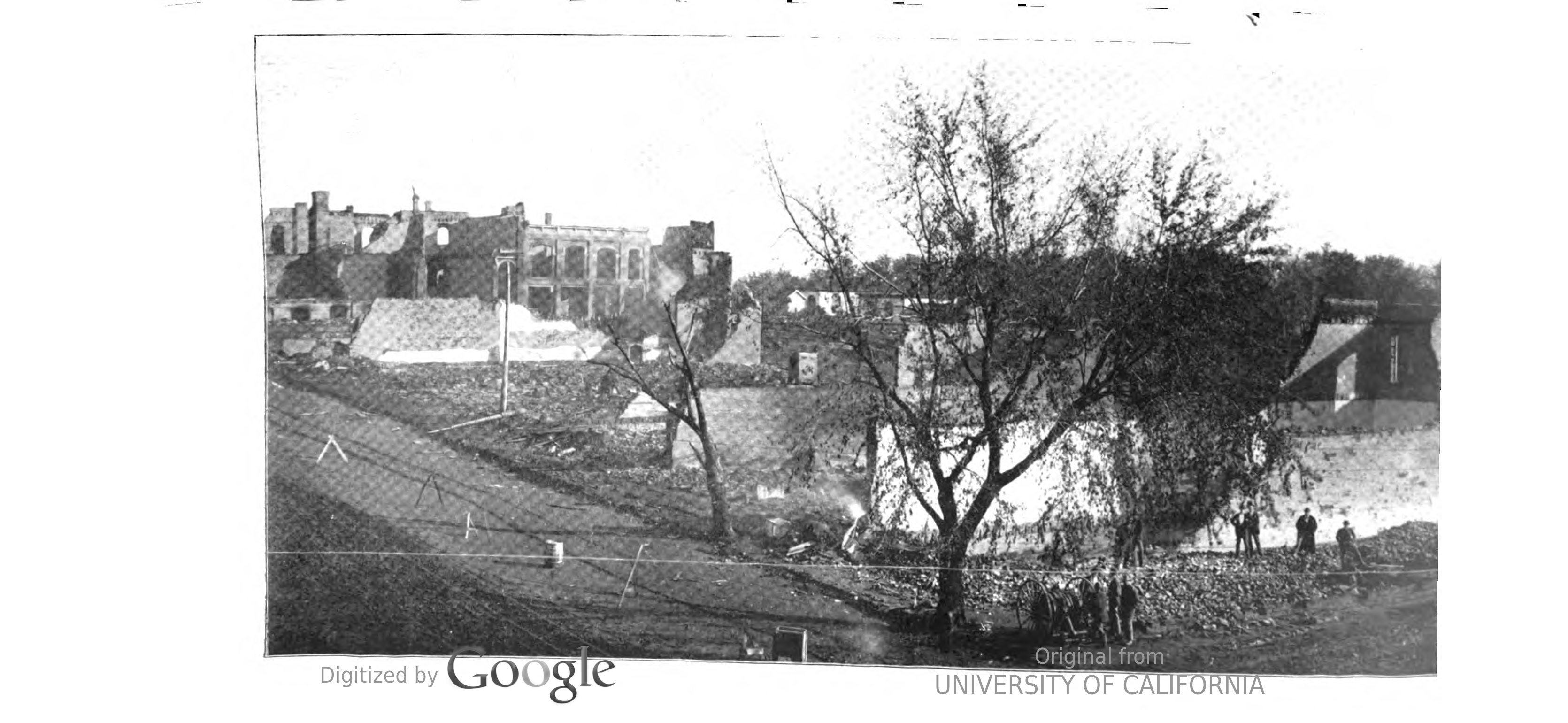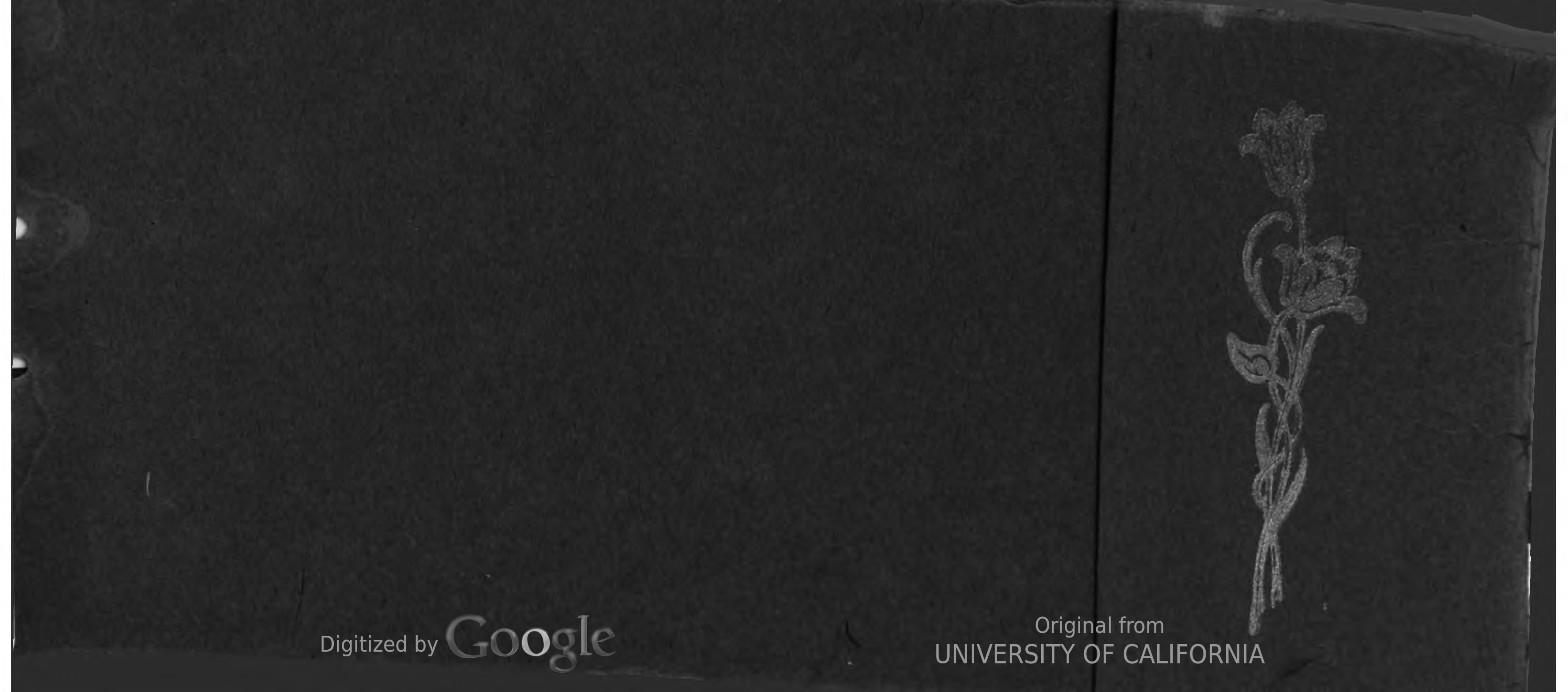
Published 1903

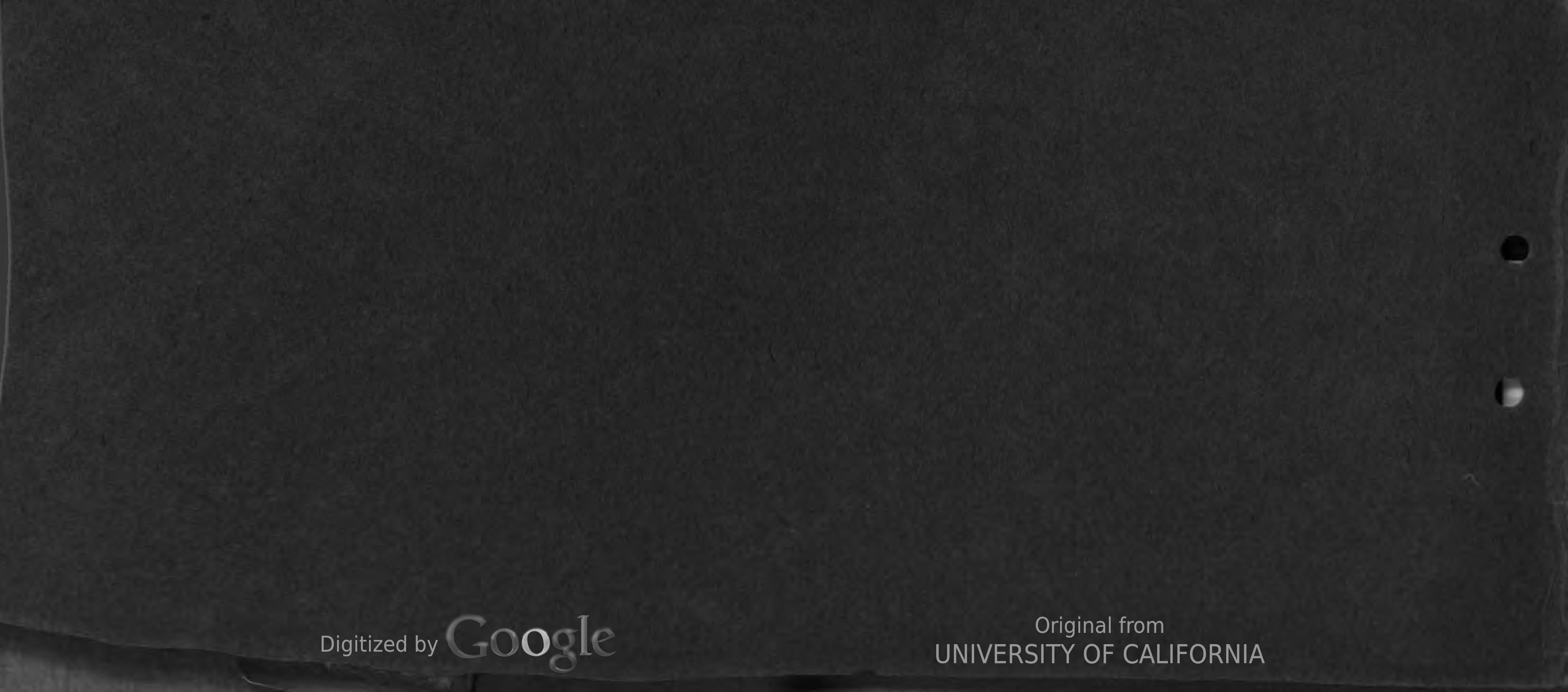
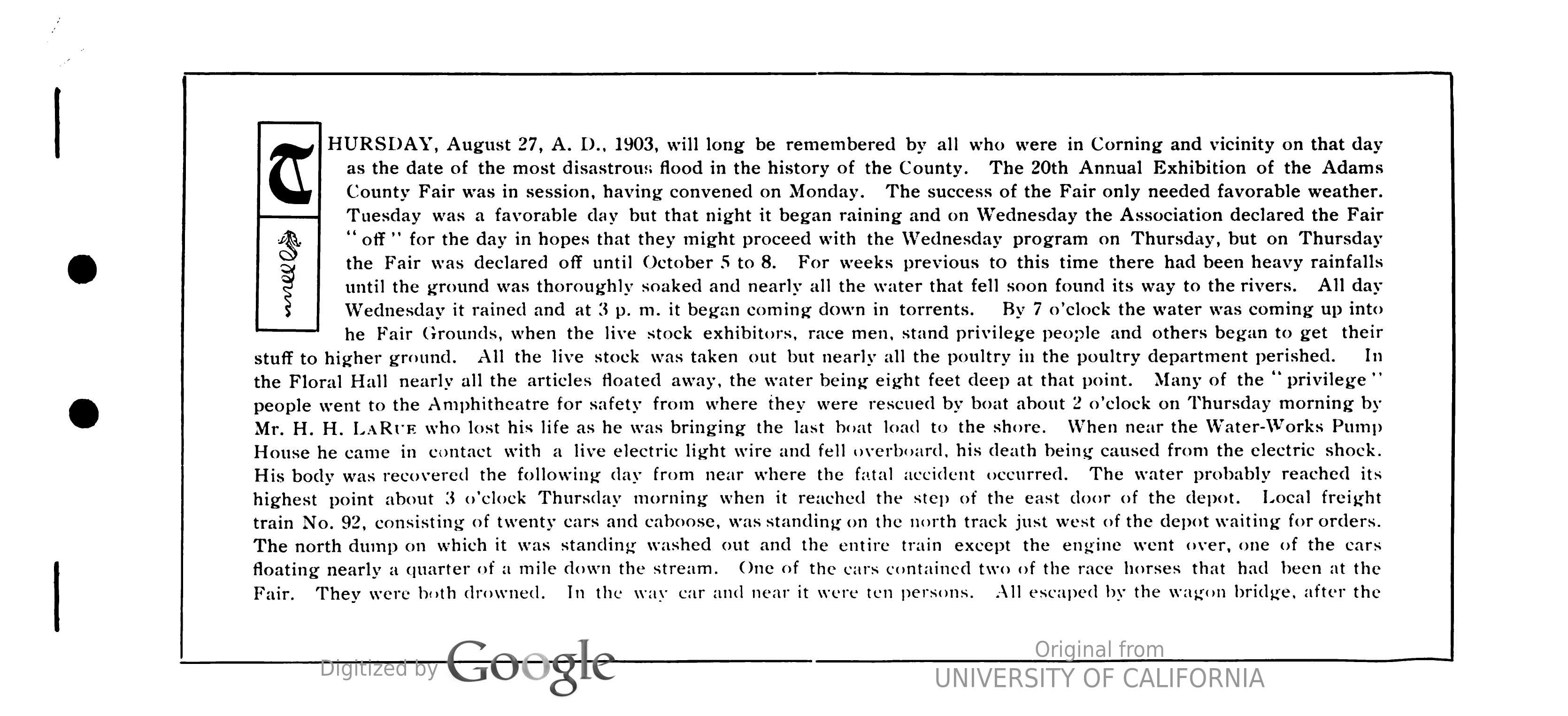
THURSDAY, August 27, A. D., 1903, will long be remembered by all who were in Corning and vicinity on that day as the date of the most disastrous flood in the history of the County. The 20th Annual Exhibition of the Adams County Fair was in session, having convened on Monday. The success of the Fair only needed favorable weather. Tuesday was a favorable day but that night it began raining and on Wednesday the Association declared the Fair "off" for the day in hopes that they might proceed with the Wednesday program on Thursday, but on Thursday the Fair was declared off until October 5 to 8. For weeks previous to this time there had been heavy rainfalls until the ground was thoroughly soaked and nearly all the water that fell soon found its way to the rivers. All day Wednesday it rained and at 3 p. m. it began coming down in torrents. By 7 o'clock the water was coming up into he Fair Grounds, when the live stock exhibitors, race men, stand privilege people and others began to get their stuff to higher ground. All the live stock was taken out but nearly all the poultry in the poultry department perished. In the Floral Hall nearly all the articles floated away, the water being eight feet deep at that point. Many of the “privilege" people went to the Amphitheatre for safety from where they were rescued by boat about 2 o'clock on Thursday morning by Mr. H. H. LARUE who lost his life as he was bringing the last boat load to the shore. When near the Water-Works Pump House he came in contact with a live electric light wire and fell overboard, his death being caused from the electric shock. His body was recovered the following day from near where the fatal accident occurred. The water probably reached its highest point about 3 o'clock Thursday morning when it reached the step of the east door of the depot. Local freight train No. 92, consisting of twenty cars and caboose, was standing on the north track just west of the depot waiting for orders. The north dump on which it was standing washed out and the entire train except the engine went over, one of the cars floating nearly a quarter of a mile down the stream. One of the cars contained two of the race horses that had been at the Fair. They were both drowned. In the way car and near it were ten persons. All escaped by the wagon bridge, after the

train went over, except J. E. Phillips, of Creston, a brakeman, and two boys of the same place, BEN HARVEY and ERNEST Dickson. They went with the swift current, finally lodging in a tree near the residence of J. W. ALEXANDER at the head of Grove Avenue from which place they were rescued the next morning. The heroism and generalship displayed by Phillips in protecting and caring for the boys justly receives the commendation of all. R. F. Tubbs, proprietor of the Lindell Hotel, was drowned between the hotel and depot. It is supposed he started to rescue the deaf mute, MR. DARNELL, south of the track, and was caught in the current and carried a short distance to where his body was found Saturday evening by his son, JAY. The family of Mr. and Mrs. WILLIAM SANBURN and four children, living southwest of Nodaway, while being rescued on a raft, the raft was upset, the mother and her two youngest children, aged 1 and 4 years, were drowned. Their bodies were recovered. The last train through Corning was No. 14 at 8:21 p. m. Wednesday until No. 1 at 7 a. m. on Saturday. After the water had subsided, a large force of men was put to work on the temporary repair of the track. The first washout was near Prescott, the next east of the overhead bridge at Corning where the water washed through the dump, and between Corning and Brooks were four more, the worst being the one just west of the Corning station. The rainfall on Wednesday and Thursday was nearly 10 inches, while from 7 p. m. on Wednesday until Thursday morning the precipitation was 6.75 inches. Two illustrations represent the destruction wrought by the cyclone at Brooks May 26, 1903, causing a loss of $25,000 and injuring several persons, none seriously. For the use of the illustrations in this SOUVENIR we are indebted to the Union-Republican and Free Press and to W. B. ANKENY for the use of the scene of the great Corning fire of October 9, 1896, in which all the business houses from the Beymer block (now occupied by the Andrews' Clothing Store) to the U. B. church were destroyed, entailing a loss of $150,000.
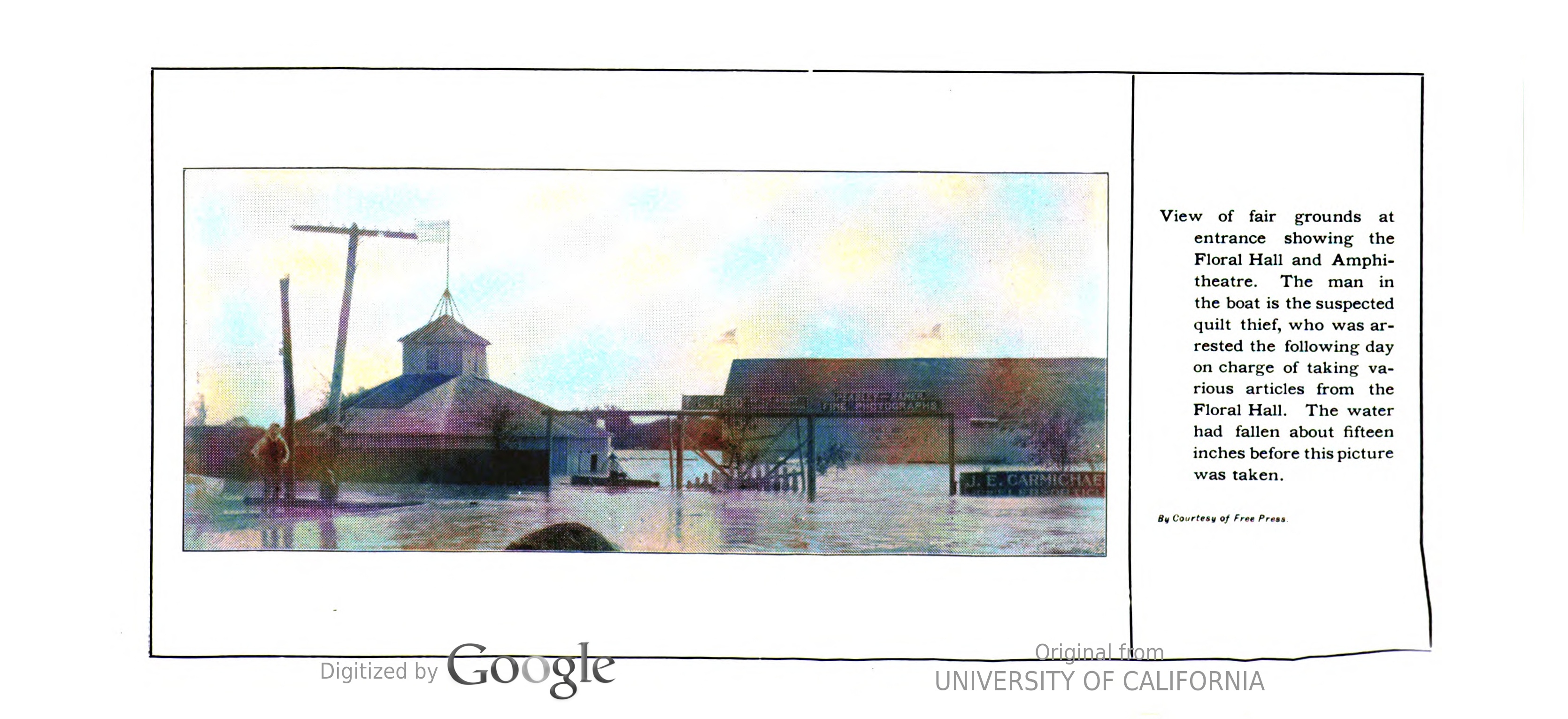
View of fair grounds at entrance showing the Floral Hall and Amphitheatre. The man in the boat is the suspected quilt thief, who was arrested the following day on charge of taking various articles from the Floral Hall. The water had fallen about fifteen inches before this picture was taken.
By Courtesy of Free Press
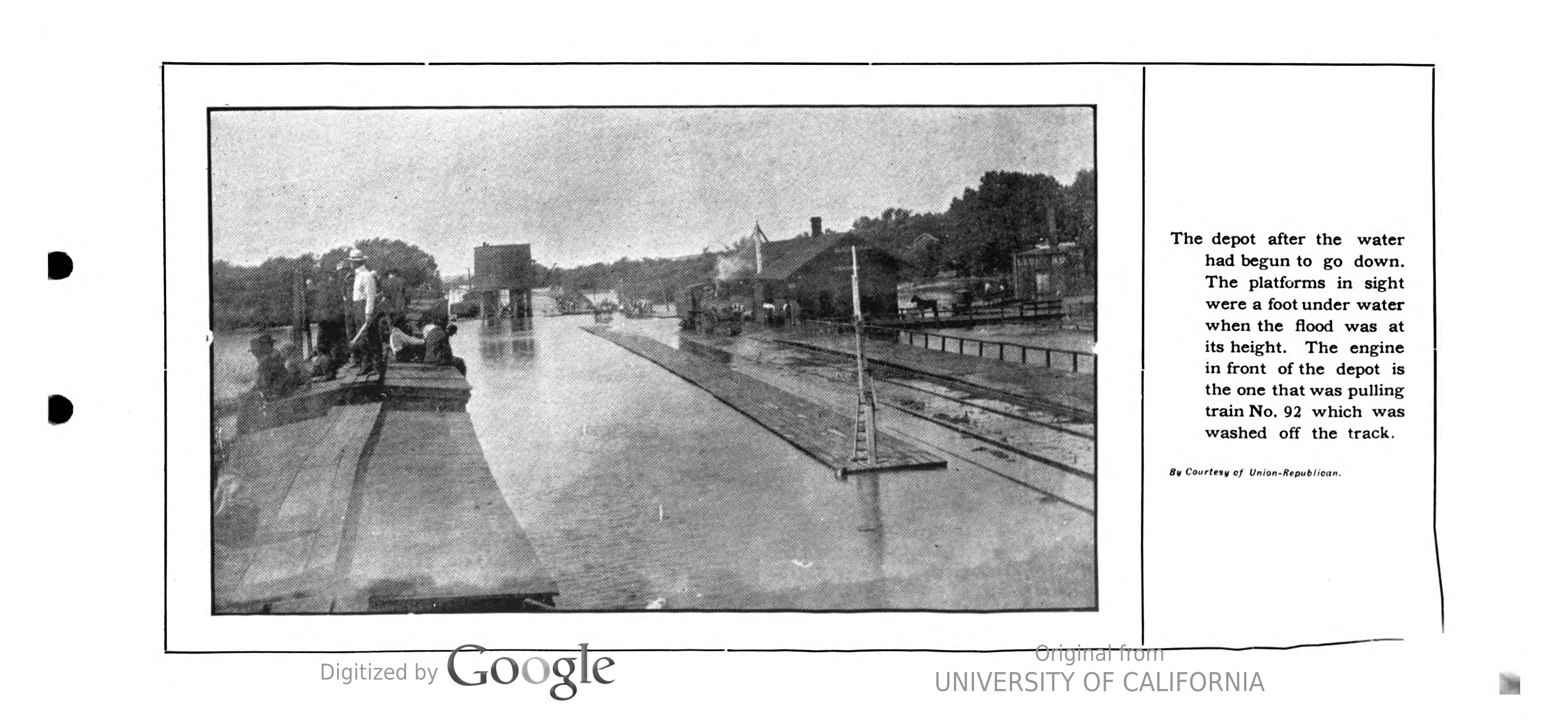
The depot after the water had begun to go down. The platforms in sight were a foot under water when the flood was at its height. The engine in front of the depot is the one that was pulling train No. 92 which was washed off the track.
By Courtesy of Union-Republican
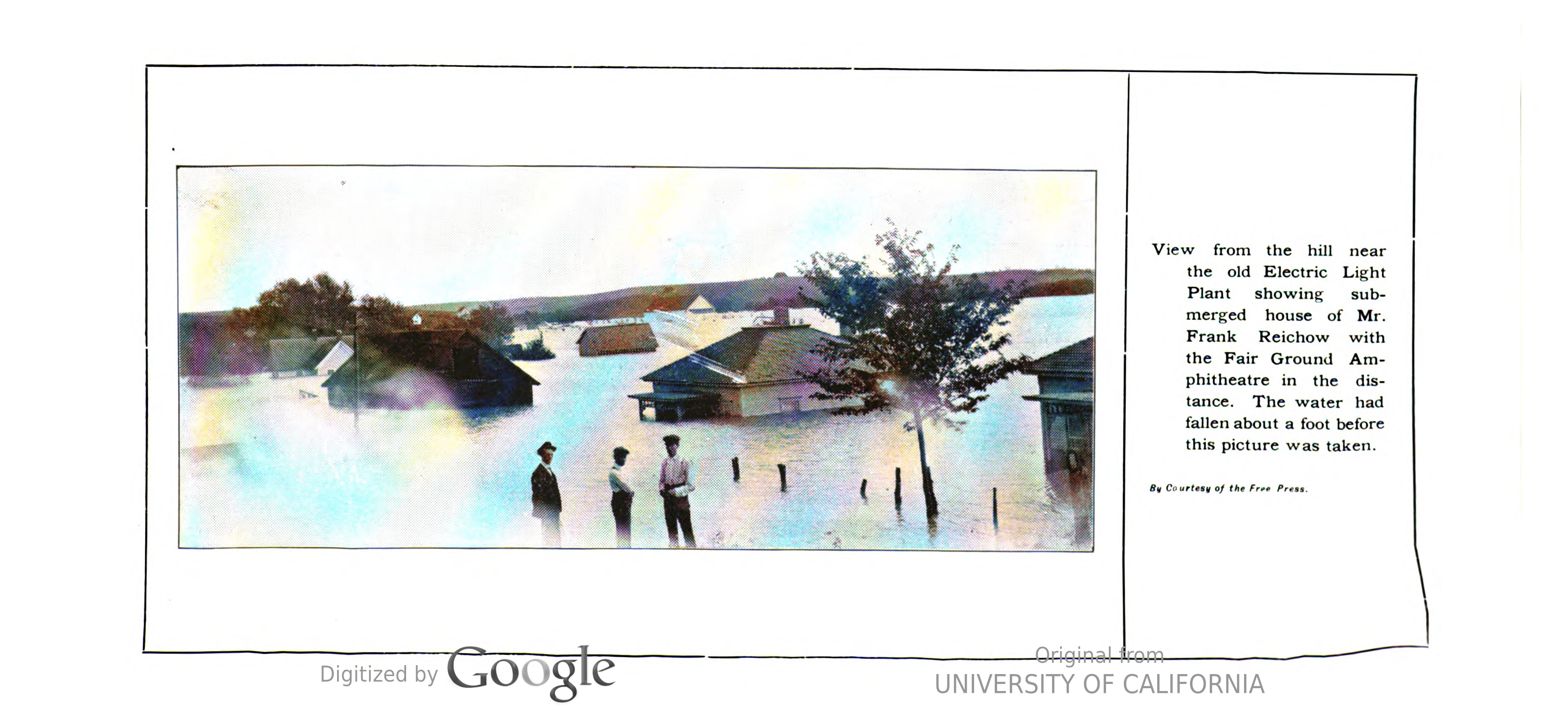
View from the hill near the old Electric Light Plant showing submerged house of Mr. Frank Reichow with the Fair Ground Amphitheatre in the distance. The water had fallen about a foot before this picture was taken.
By Courtesy of the Free Press
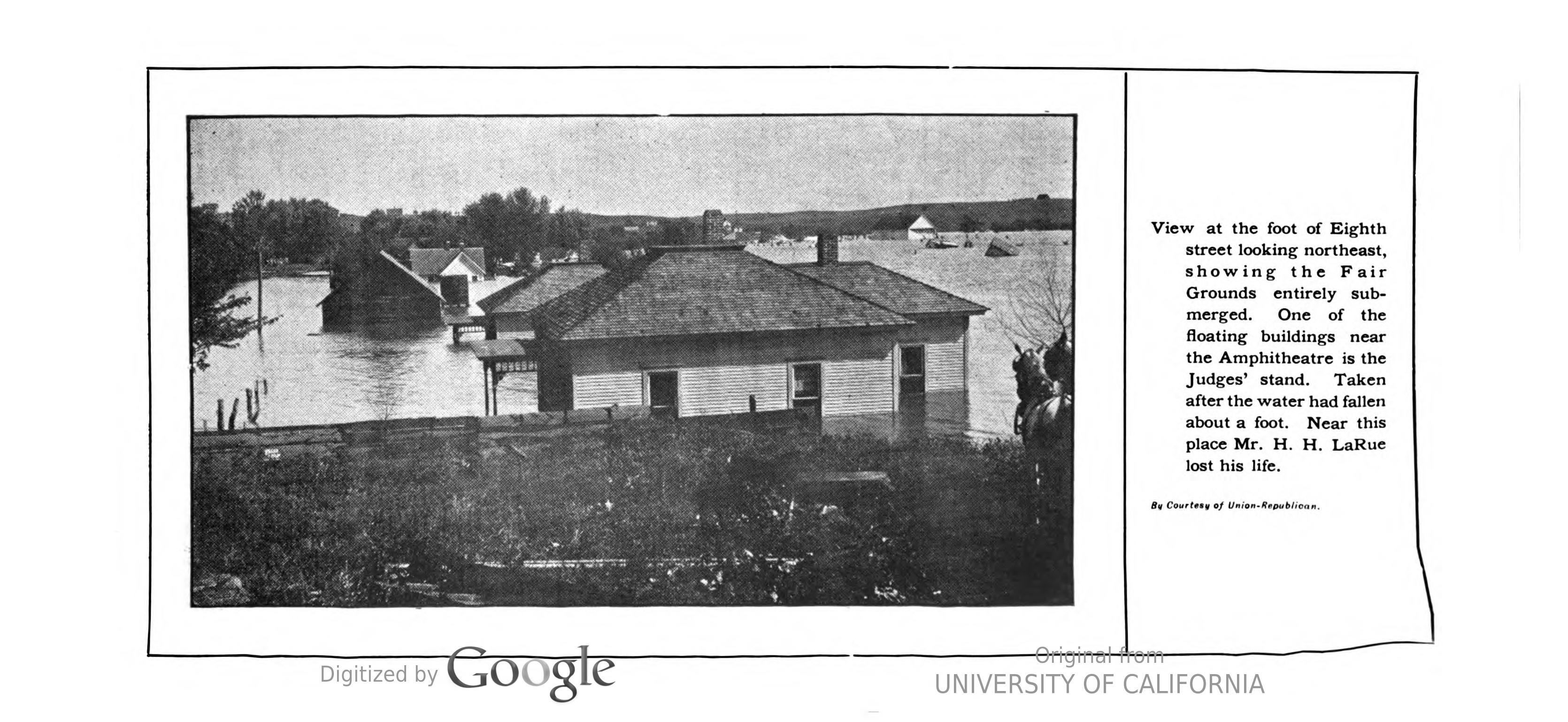
View at the foot of Eighth street looking northeast, showing the Fair Grounds entirely submerged. One of the floating buildings near the Amphitheatre is the Judges' stand. Taken after the water had fallen about a foot. Near this place Mr. H. H. LaRue lost his life.
By Courtesy of Union-Republican
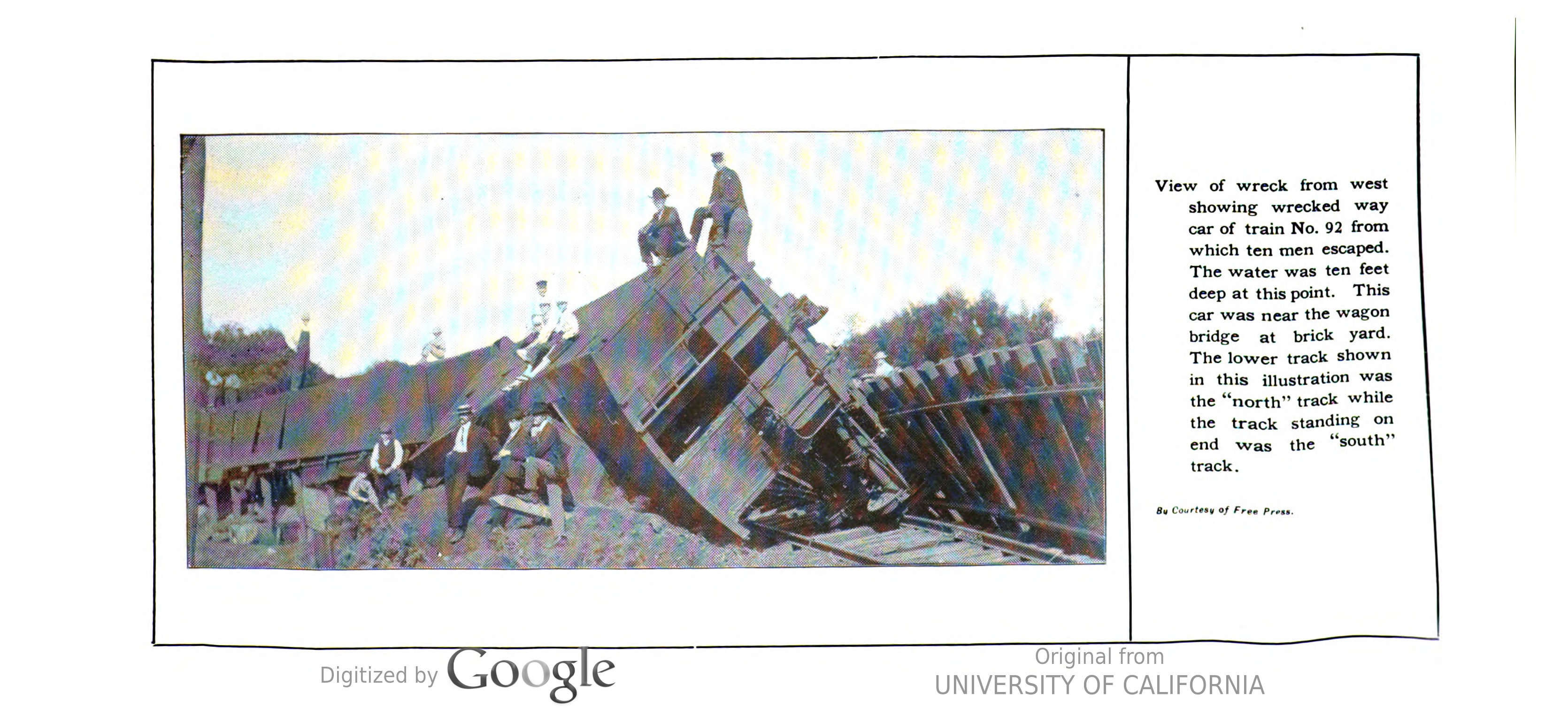
View of wreck from west showing wrecked way car of train No. 92 from which ten men escaped. The water was ten feet deep at this point. This car was near the wagon bridge at brick yard. The lower track shown in this illustration was the “north” track while the track standing on the end was the “south” track.
By Courtesy of Free Press
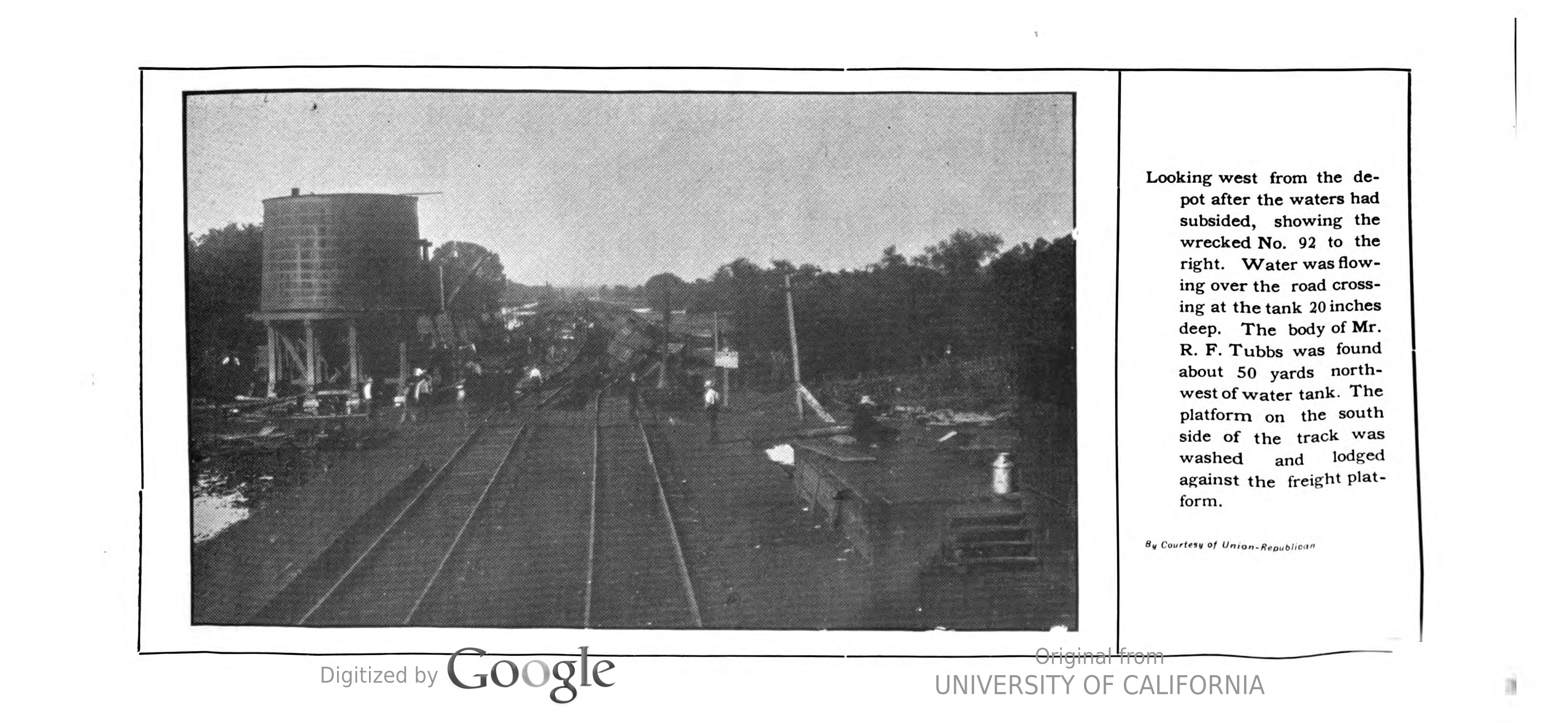
Looking west from the depot after the waters had subsided, showing the wrecked No. 92 to the right. Water was flowing over the road crossing at the tank 20 inches deep. The body of Mr. R. F. Tubbs was found about 50 yards northwest of water tank. The platform on the south side of the track was washed and lodged against the freight platform.
By Courtesy of Union- Republican
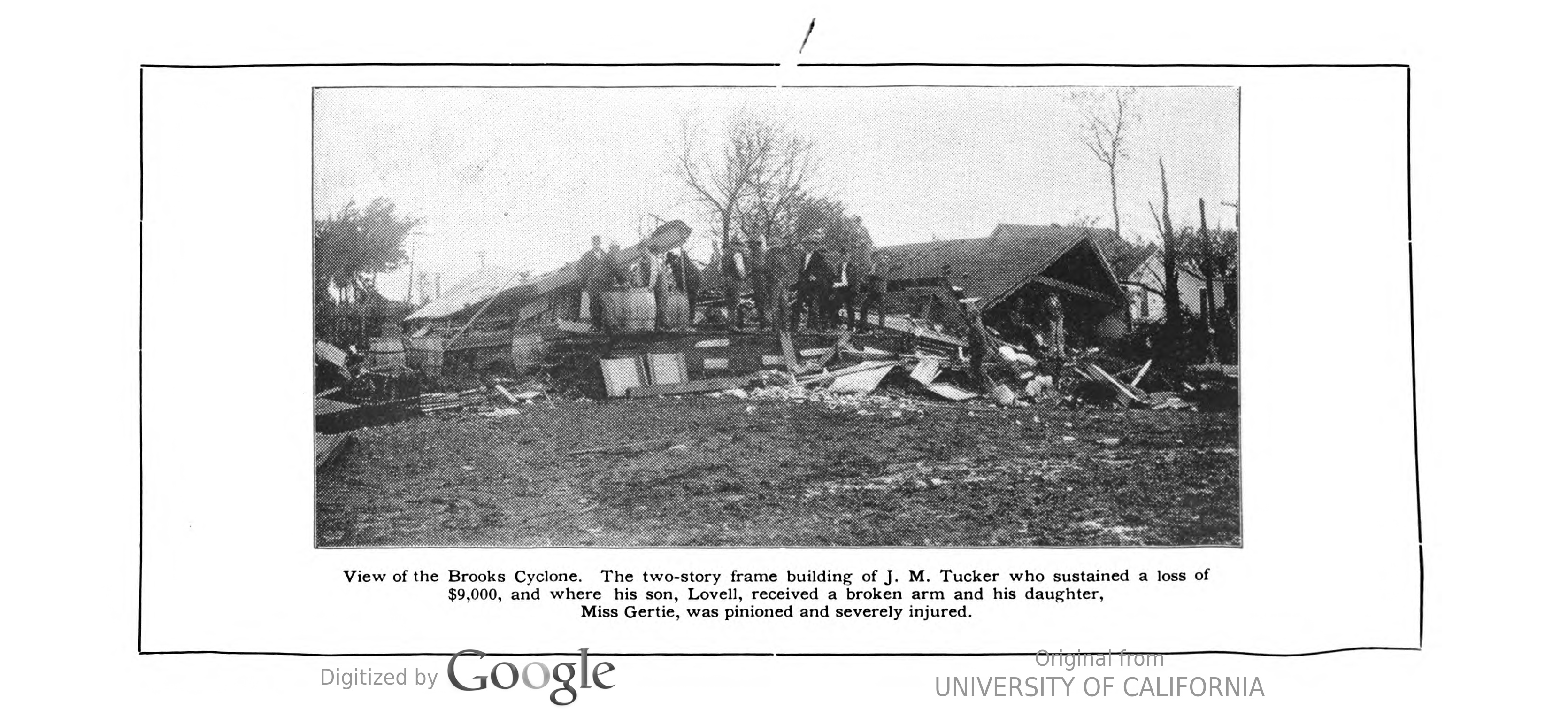
View of the Brooks Cyclone. The two-story frame building of J. M. Tucker who sustained a loss of $9,000, and where his son, Lovell, received a broken arm and his daughter, Miss Gertie, was pinioned and severely injured.
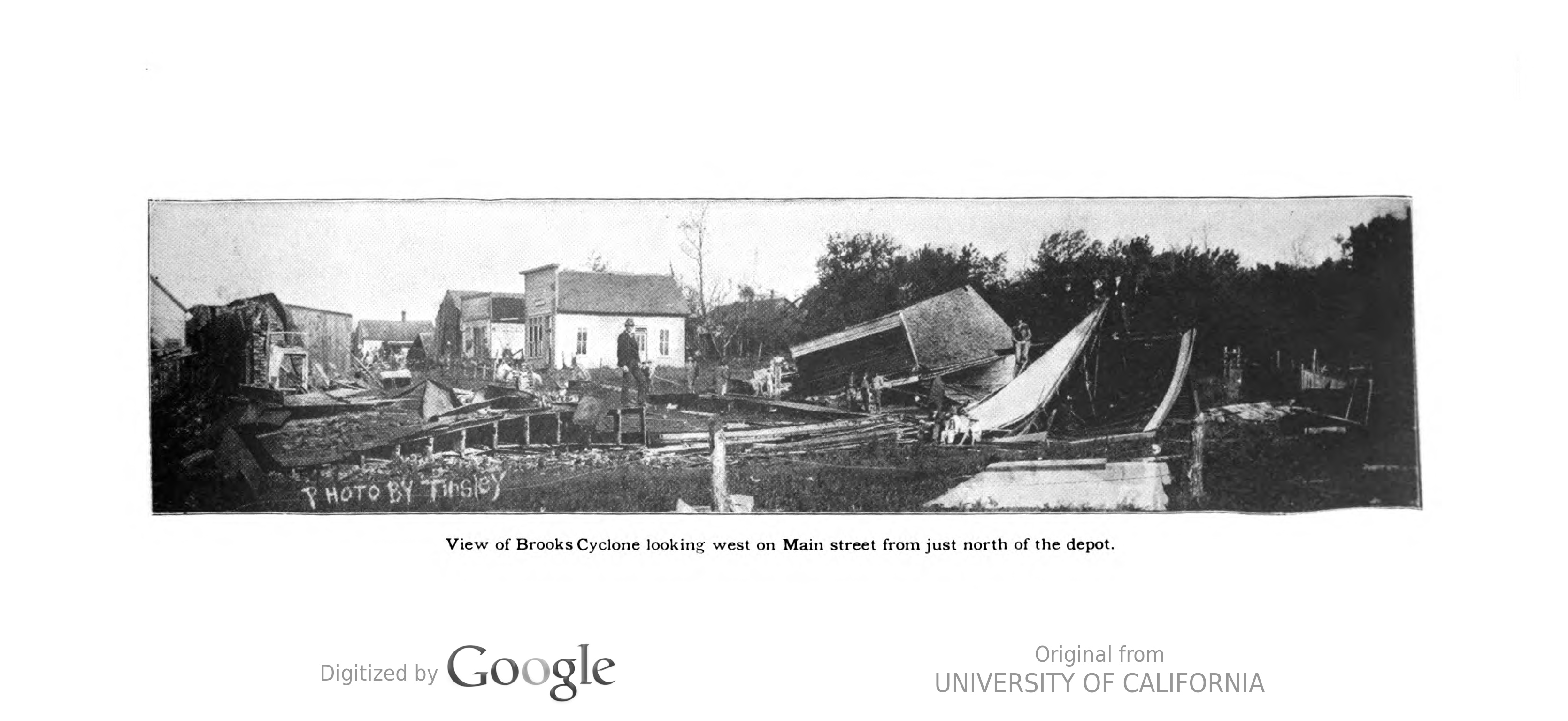
View of Brooks Cyclone looking west on Main street from just north of the depot.
